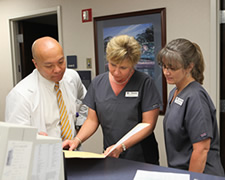Conditions

Retinal Detachment
The retina is the light-sensitive layer of tissue that lines the inside of the eye and sends visual images through the optic nerve to the brain.
A detached retina occurs when this layer of tissue is lifted or pulled away from its underlying support. The retina cannot properly function when these layers detach and if not promptly treated, permanent vision loss may occur. Individuals with certain eye conditions such as extreme myopia, diabetes and sickle cell anemia have an increased risk for retinal detachment.
A retinal detachment occurs when the retina’s sensory and pigment layers separate. Because it can cause devastating damage to the vision if left untreated, retinal detachment is considered an ocular emergency that requires immediate medical attention and surgery. It is a problem that occurs most frequently in the middle-aged and elderly.
There are three types of retinal detachments. The most common type occurs when there is a break in the sensory layer of the retina, and fluid seeps underneath, causing the layers of the retina to separate.
Those who are very nearsighted, have undergone eye surgery, or have experienced a serious eye injury are at great risk for this type of detachment. Nearsighted people are more susceptible because their eyes are longer than average from front to back, causing the retina to be thinner and more fragile.
- Nsectetur cing elit.
- Suspe ndisse suscipit sagittis leo.
- Entum estibulum dignissim posuere.
- If you are going to use a passage.
Patient Frequently Asked Questions
There are several causes of retinal detachment. In some cases, tissue detachment occurs as a result of increased pressure in the eye during surgery.
Fluid movement or new vessels growing under the retina, as in the case of diabetic retinopathy, can push the retina away from its supporting network of tissue. Small, torn areas called retinal tears or retinal breaks can lead to detachment. Injuries or a sudden blow to the head can also cause the retina tissue to detach.
Common symptoms include a sudden or gradual increase in the number of floaters and/or light flashes in the eye. Your vision might become blurry, or a shadow or curtain appears to fall over the field of vision typically from the top or side of your eye.
A retinal detachment does not cause pain yet is considered a medical emergency. Anyone experiencing the symptoms of a retinal detachment should see an eye care professional immediately.
Small retinal tears and holes are diagnosed during a comprehensive eye examination.
Retinal detachments are treated with surgery. In some cases, a tiny synthetic band, known as a scleral buckle, is attached to the outside of the eyeball to gently push the wall in place. In some cases, silicone oil and intraocular gas are used to reattach the retina. Smaller holes and tears in the retina are treated with laser surgery or with a freezing treatment called cryopexy, typically performed in the doctor’s office to bond the tissue in place.


